
Turek is a town in central Poland with 31,282 inhabitants as of 2009. It is the capital of Turek County in the Greater Poland Voivodeship. It is located in the Sieradz Land.
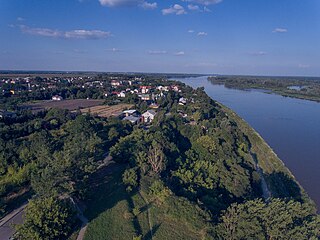
Wyszogród is a town in central Poland, in Masovian Voivodeship, in Płock County, by the Vistula River. The population of Wyszogród was 2,793 in 2004.
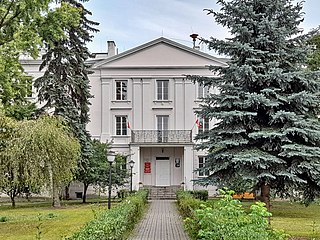
Radzymin is a town in Poland and is one of the distant suburbs of the city of Warsaw. It is located in the powiat of Wołomin of the Masovian Voivodeship. The town has 8,818 inhabitants.
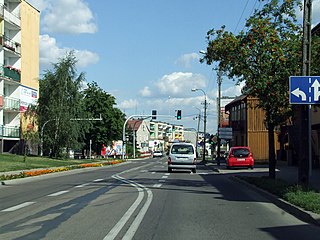
Żuromin is a town in north-central Poland, in Masovian Voivodeship, about 120 kilometres northwest of Warsaw. It is the capital of Żuromin County.

Pyzdry is a town in Września County, Greater Poland Voivodeship, Poland, with 3,228 inhabitants (2010).

Golina is a town in Konin County, Greater Poland Voivodeship, in central Poland, with 4,398 inhabitants (2010). It is located 12 km (7.5 mi) west from Konin.

Ślesin is a town in Konin County, Greater Poland Voivodeship, in central Poland, with 3,200 inhabitants (2010).

Białaszewo is a village in the administrative district of Gmina Grajewo, within Grajewo County, Podlaskie Voivodeship, in north-eastern Poland. It lies approximately 16 kilometres (10 mi) south of Grajewo and 62 km (39 mi) north-west of the regional capital Białystok.
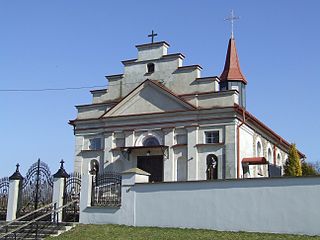
Poryte is a village in the administrative district of Gmina Stawiski, within Kolno County, Podlaskie Voivodeship, in north-eastern Poland. It lies approximately 6 kilometres (4 mi) west of Stawiski, 12 km (7 mi) south-east of Kolno, and 78 km (48 mi) west of the regional capital Białystok.
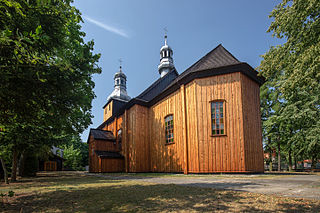
Węglewice is a village in the administrative district of Gmina Galewice, within Wieruszów County, Łódź Voivodeship, in central Poland. It lies approximately 7 kilometres (4 mi) north-west of Galewice, 12 km (7 mi) north-east of Wieruszów, and 97 km (60 mi) south-west of the regional capital Łódź.
Sprowa is a village in the administrative district of Gmina Słupia, within Jędrzejów County, Świętokrzyskie Voivodeship, in south-central Poland. It lies approximately 6 kilometres (4 mi) west of Słupia, 30 km (19 mi) west of Jędrzejów, and 61 km (38 mi) south-west of the regional capital Kielce.

Ignacewo is a village in the administrative district of Gmina Ślesin, within Konin County, Greater Poland Voivodeship, in central Poland. It lies approximately 10 kilometres (6 mi) east of Ślesin, 22 km (14 mi) north-east of Konin, and 104 km (65 mi) east of the regional capital Poznań.

Rataje is a village in the administrative district of Gmina Pyzdry, within Września County, Greater Poland Voivodeship, in west-central Poland. It lies approximately 3 kilometres (2 mi) north-east of Pyzdry, 19 km (12 mi) south-east of Września, and 60 km (37 mi) south-east of the regional capital Poznań.
The Battle of Szydłowiec took place in the night of 22–23 January 1863, during the January Uprising. It began when Polish insurgents under Captain August Jasiński and Colonel Marian Langiewicz attacked the town of Szydłowiec, where a garrison of the Imperial Russian Army stayed.

The Battle of Rawa was one of skirmishes of the Polish January Uprising. It took place on 4 February 1863 in the town of Rawa Mazowiecka, Russian-controlled Congress Poland. A unit of Polish insurgents under Antoni Jeziorański, and Aleksander and Franciszek Sokołowski, managed to capture barracks of the Imperial Russian Army. The remaining Russians retreated towards Skierniewice. With several pieces of weaponry and an unknown number of prisoners, the Poles then headed southwards.

The Battle of Sosnowiec was one of battles of the January Uprising. It took place in the night of 6–7 February 1863, between Polish insurgents under Colonel Apolinary Kurowski, and the Imperial Russian Army garrison stationed in the town of Sosnowiec, in the Russian-ruled territory known officially as the ‘Kingdom of Poland’, otherwise Congress Poland.

The First Battle of Ignacewo was one of many clashes of the January Uprising. It took place on May 8, 1863, near the village of Ignacewo, which at that time belonged to Russian Empire’s Congress Poland. Insurgent forces commanded by Edmund Taczanowski clashed with a 2,000-strong detachment of the Imperial Russian Army led by Andrei Brunner. The battle ended with Russian victory, and Poles lost some 160 men.

The Battle of Lututów was a clash between Polish rebel forces and units of the Imperial Russian Army. It took place during the January Uprising, on June 15, 1863, near the village of Lututów, which at that time belonged to Russian-controlled Congress Poland. Rebel forces, commanded by Antoni Korotyński were defeated by the Russians.

The Battle of Rybnica, one of many clashes of the January Uprising, took place on October 20, 1863, near the village of Rybnica, which at that time belonged to Russian-controlled Congress Poland. A party of 650 Polish insurgents, commanded by Dionizy Czachowski, clashed with a 500-strong detachment of the Imperial Russian Army. The clash ended in rebel victory; Russian losses were estimated at app. 50–60 killed, while Poles lost 27 killed and 30 wounded.

Poland–Sweden relations are historical and bilateral relations between Poland and Sweden. Both countries are separated by the Baltic Sea and have had a very long historical contact. They have also survived several conflicts between the two countries as well. At the beginning of the 20th century, Poland and Sweden enjoyed a close relationship, which was interrupted by the Soviet and German invasion of Poland, which started World War II. After the war, both re-established relations and Sweden has become the largest economic contributor for Poland among the Nordic countries. Both Poland and Sweden are members of the EU, NATO, OECD, OSCE, Council of the Baltic Sea States, HELCOM, Council of Europe and the World Trade Organization. There are over 90,000 Poles in Sweden and residents from both countries visit each other frequently. Sweden has given full support to Poland's membership of the European Union. Poland strongly supported Sweden's NATO membership.





















